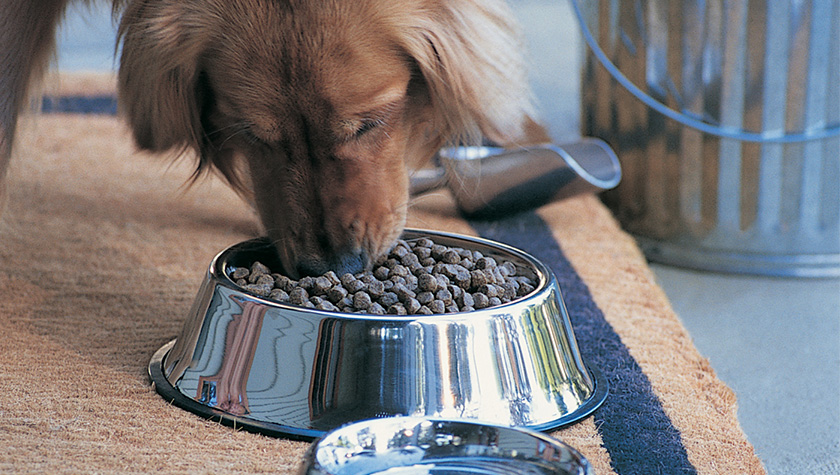What is meal in dog food? Salmon and turkey meal are used used in Supreme Source® dog food.
Turkey meal and salmon meal are protein rich ingredients. They are created by drying raw turkey or salmon to remove most of the moisture. Supreme Source recipes use turkey or salmon meal because they contain much larger quantities of protein per ounce than raw turkey or salmon alone.
Protein is an essential part of a healthy diet for pets. It helps build and repair muscles and tissues, as well as creating essential hormones and enzymes that are needed for normal function. Using meal as the primary protein source helps make sure your pet gets the nutrition he needs to live a happy, healthy life.
Common questions about meal in dog food
What are the benefits of meal in Supreme Source dog food?
Meals in dog food, such as poultry meal or fish meal, are concentrated sources of protein. Protein is essential for the growth, repair, and maintenance of tissues, muscles, and organs in dogs. High-quality protein supports overall canine health and contributes to a shiny coat and healthy skin.
Meals are often nutrient-dense, meaning they contain a high concentration of essential nutrients like vitamins and minerals. This allows dogs to get a significant amount of nutrition from a relatively small serving of food, which is particularly important for meeting their dietary requirements.
What kind of meal does Supreme Source have in its food?
Supreme Source offers several sources of meal in its dog food. The most common protein sources from meat meals include:
- Chicken Meal
- Salmon Meal
- Turkey Meal
- Lamb Meal
Check your pet food labels to confirm the amount of product meal included in the food blend that your pet eats. The quantity of product meal may vary depending on the specific blend.
There are several types of meat meal to choose from: poultry meal, like chicken meal and turkey meal are very popular.
Is meal better for dogs to eat than fresh meat?
The choice between meal (processed and rendered meat) and fresh meat for dogs depends on various factors, and both options can have their advantages when included in a well-balanced diet.
Let’s compare what the benefits of each are:
Meal proteins are often nutrient-dense as they can be processed to concentrate essential nutrients like protein, vitamins, and minerals. This can be beneficial in providing a highly nutritious diet with smaller serving sizes.
Meals are typically processed to be highly digestible. The processing methods used in creating meal proteins can break down proteins and other nutrients, making them easier for dogs to absorb and utilize. The rendering process from pet food manufacturers may vary depending on the specific process used. This can impact protein level and can vary when pet food ingredients use quality ingredients to provide a premium protein meal.
Dog food manufacturers have more control over the quality and consistency of meals during the cooking process. This is because they can precisely measure and control the content of nutrients in the final product, ensuring that dogs receive a consistent and balanced diet from the specific animal meal.
Fresh meat like real chicken is in its natural form and less processed than meals. It can provide dogs with a source of protein in a form that closely resembles what they might eat in the wild.
Real meat proteins can be hard to digest, and may not have as much concentrated protein. Meal also includes quality ingredients to supplement the meat proteins and nutrient digestibility.
Meal typically will have a longer shelf life, avoids harmful bacteria, limits fatty tissue compared to real meat, offers all nutritional requirements for your dog, and offers the essential building blocks for a healthy diet like amino acids.
The nutritional quality derived from the rendered products creates an exceptional finished product.
What meal is best for my dog?
As a pet parent, you want the best for your dog. We recommend trying different meals and consulting with your veterinarian. Each of Supreme Source’s meal blends offer real food. The real food we use in our recipes includes common dog food ingredients from pet food companies.
In addition to seeking real food, we aim to use sustainable foods in our recipes to ensure our meals offer all the building blocks of nutrition.
When you think about meal, it may be helpful to compare it to a concentrated protein powder that you might take as a supplement. Meal offers a nutritionally concentrated food source that would be found in human food or real food, but is packed full of the ingredients needed for balanced nutrition. This is how meal works for animal food vs human food.
Some dogs may also benefit from alternative meal ingredients. While high-quality meat meal is an excellent option, your dog may for instance have an issue digesting chicken meat meal. In this case, soybean meal is an alternative protein source found in a meal ingredient that includes other sustainable foods. The digestibility of soybean meal makes it a popular alternative.
What is crude protein?
Crude protein in dog food is a rough estimate of the total protein content, including both animal and plant-based sources of protein. It doesn’t provide information about the quality or source of the protein, the amino acid profile, or how easily the protein can be digested and utilized by your dog.
Crude protein is a different form of protein that still offers the distribution of nutrients your dog needs. The level of the digestible protein can be different depending on the source of the protein.
How do I ensure my dog’s dry food is full of protein?
It’s best to consult with a veterinarian. While we do not offer nutritional advice, here are some general pointers. To ensure that your dog’s dry food is full of protein, you might consider the following tips when selecting or evaluating dog food:
- Read the ingredients list. Look for a high-quality dog food with a named animal protein meal source (e.g., chicken, beef, turkey, fish) listed as the first ingredient. The first ingredient should ideally be a meat or meat meal, not a grain or filler.
- Check the guaranteed analysis. The packaging should provide a guaranteed analysis that includes the minimum percentage of crude protein. Aim for a dry dog food with a protein content of at least 18-20% for adult dogs and 25-30% for puppies. The specific protein requirements can vary depending on your dog’s age, activity level, and health.
- Consider the protein source. Pay attention to the source of the protein. Animal-based proteins are generally more easily digestible and biologically appropriate for dogs. Ensure that the protein sources are high-quality and not by-products.
Does Supreme Source offer a feeding guide?
Supreme Source is here to help guide you through every step of your pet’s nutrition journey. We recommend this feeding guide to make sure your dog is getting the proper nutrients.
Feed guides may change based on specific weight, nutrients, and age. For example, a puppy needs different food than an adult dog, and your dog’s weight can change how much they need to eat.
How do I know what a healthy calorie content is?
Determining a healthy calorie content for your dog involves considering several factors, including your dog’s age, size, activity level, and any specific health requirements. Here are steps to help you estimate an appropriate calorie intake for your dog:
- Consult your veterinarian. Your veterinarian is the best resource for assessing your dog’s specific calorie needs. They can provide guidance based on your dog’s individual characteristics, such as breed, age, weight, and overall health.
- Calculate maintenance calories. The most common method to estimate a dog’s maintenance calories is to use their Resting Energy Requirement (RER) or Maintenance Energy Requirement (MER). The RER is calculated as follows for a typical adult dog:
RER (in calories/day) = 70 x (body weight in kg)^0.75
The MER, which accounts for your dog’s activity level, is calculated by multiplying the RER by a multiplier, which can range from 1.2 (sedentary) to 2.5 (very active). Your veterinarian can help determine the appropriate multiplier for your dog’s activity level.
- Consider special dietary needs. Dogs with certain health conditions, such as obesity, diabetes, or food allergies, may have different calorie requirements. Specialized diets may be necessary, and your vet can provide specific recommendations.
- Monitor your dog’s weight. Keep an eye on your dog’s weight and body condition score. Adjust their calorie intake accordingly. If your dog is gaining weight, you may need to reduce their calorie intake, while if they’re losing weight or too thin, you might need to increase it.
- Follow feeding guidelines. Use the feeding guidelines provided on the packaging of your dog’s commercial food as a starting point. These guidelines often provide a range of recommended daily calories based on the dog’s weight. However, keep in mind that individual dogs may have different needs, so adjustments may be necessary.
- Activity level. Dogs with higher activity levels, such as working dogs or highly active breeds, may require more calories. Conversely, less active dogs, such as senior dogs or small breeds, may require fewer calories.
- Age and life stage. Puppies, adult dogs, and senior dogs have different calorie requirements. Puppies generally need more calories for growth, while senior dogs may require fewer calories to maintain a healthy weight.
What protein source is best for my dog?
Natural protein sources are great for a dog as they help support lean muscle mass, healthy vision, and healthy skin, and the protein-packed ingredients offer omega fatty acids to support all healthy functions for your dogs.
So while fresh chicken may seem like the best option, Supreme Source Dog Food and all our blends offer an excellent source of protein, whether it’s the wild boar blend, our premium source salmon, salmon meal, turkey meal, or any other option, we have you covered with all the nutrients that your dog needs.
Our healthy blend includes a blend of fruits that offers fiber content for healthy skin and omega fatty acids to promote healthy vision and support lean muscle mass.
Put our awesome product to the test and see how much it helps your pup!


